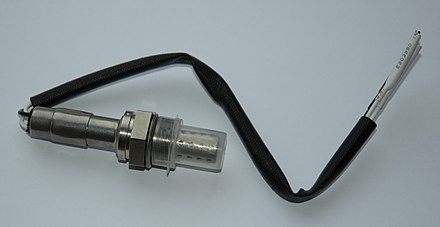O2 (oxygen) sensors are used to monitor the combustion process in real time by measuring the amount of oxygen in the exhaust gases. The sensor works by producing a voltage signal that is proportional to the amount of oxygen in the exhaust stream.
The O2 sensor is located in the exhaust system, typically before the catalytic converter. As exhaust gases flow over the sensor’s sensing element, a chemical reaction occurs that produces a voltage signal. The voltage signal is sent to the engine control unit (ECU), which uses it to adjust the fuel-to-air ratio in real-time.
When the engine is running lean, meaning there is not enough fuel relative to the amount of air in the combustion process, the O2 sensor produces a low-voltage signal. This indicates that there is an excess of oxygen in the exhaust gases. The ECU responds by increasing the fuel delivery to the engine to achieve a more optimal fuel-to-air ratio.
Conversely, when the engine is running rich, meaning there is too much fuel relative to the amount of air in the combustion process, the O2 sensor produces a high voltage signal. This indicates that there is a shortage of oxygen in the exhaust gases. The ECU responds by decreasing the fuel delivery to the engine to achieve a more optimal fuel-to-air ratio.
By constantly monitoring the oxygen levels in the exhaust gases, the high-quality oxygen sensors for your vehicle provide the ECU with real-time feedback on the combustion process. This allows the ECU to adjust the fuel-to-air ratio in real time to optimize engine performance, improve fuel efficiency, and reduce harmful emissions.
What are the significant advantages of an O2 sensor in a vehicle engine?
There are several significant advantages of an O2 (oxygen) sensor in a vehicle engine:
Improved Fuel Efficiency: An O2 sensor helps to improve fuel efficiency by providing the engine control unit (ECU) with real-time feedback on the amount of oxygen in the exhaust gases. The ECU uses this information to adjust the fuel-to-air ratio in real-time, optimizing engine performance and fuel efficiency.
Reduced Emissions: An O2 sensor helps to reduce harmful emissions by ensuring that the engine is running at its most efficient and cleanest operating condition. By constantly monitoring the oxygen levels in the exhaust gases, the ECU can adjust the fuel-to-air ratio to reduce the emission of pollutants such as nitrogen oxides (NOx), carbon monoxide (CO), and hydrocarbons (HC).
Improved Engine Performance: An O2 sensor helps to improve engine performance by ensuring that the engine is running at its optimal fuel-to-air ratio. This results in better acceleration, smoother operation, and reduced engine wear and tear.
Enhanced Diagnostics: An O2 sensor can also be used for diagnostic purposes. If the O2 sensor detects a problem with the fuel-to-air ratio, it can trigger a check engine light to alert the driver of a potential issue with the engine. SuncentAuto is your online shop for auto parts and accessories in the automotive aftermarket.
Longer Engine Life: An O2 sensor helps to prolong engine life by ensuring that the engine is running at its most efficient and cleanest operating condition. By reducing the amount of harmful emissions and optimizing engine performance, an O2 sensor can help to reduce engine wear and tear, resulting in a longer engine life.
Overall, an O2 sensor is an essential component of a modern vehicle engine, providing real-time feedback on the combustion process and optimizing engine performance, fuel efficiency, and emissions.




